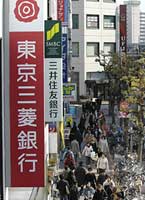|
|
|||||||
|
|
|||||||
|
|||||||
| | Web Japan >> | Trends in Japan >> | Business & Economy >> | Payback Time | |
|
PAYBACK TIME Major Banks Accelerate Repayment of Public Funds (October 12, 2005) Now that Japan's economy is on the upswing, the nation's major banks are speeding up their repayments of the funds the government provided them to sort out the bad-loan crisis of the 1990s. All of the big banks look set to complete the repayments in the near future. Mizuho Financial Group, for example, has repaid fully 70% of the money that it originally received. This trend heralds a turning-point in the policies of ultra-low-interest rates and injections of public funds that sustained the country's banks during the long slump of the post-bubble years. Helping Hands Four other banks - Mitsubishi Tokyo Financial Group, Sumitomo Trust & Banking Co., Bank of Yokohama, and Kansai Urban Banking Corp. - have already repaid the government assistance they received in full. Efforts by Japan's megabanks to repay the more than ¥1 trillion ($9.1 billion) of funds injected into them by the government have also gained momentum. Mitsubishi UFJ Financial Group, which will be created out of a merger in January 2006, and Sumitomo Mitsui Financial Group both aim to fully repay the government assistance they received by the end of fiscal 2007. The government injected funds into troubled banks on several occasions, beginning with a capital injection in March 1998 based on the Financial Function Stabilization Law. The assistance took such forms as preferred stock purchases, the aim being to increase the banks' capital to stabilize their operations and head off a financial crisis or credit crunch. Now that the banks have disposed of the bulk of their non-performing loans and are shifting their focus to forward-looking business priorities, they are keen to end a situation in which the government is one of their major shareholders, which some analysts feels restricts the banks' freedom of action. A total of ¥12.4 trillion ($112.7 billion) of public funds had been injected into the banks as of March 2005, and ¥8.9 trillion ($81 billion), or 70% of the total, remained outstanding. The government has profited from the return of the funds, as the banks are at last able to repay the assistance they received. Turning Point A look at the latest economic indices reveals an improving economic environment. The ratio of job offers to applicants in July stood at 0.97, the highest for more than 12 years. Similarly, in April workers' base salaries were at their highest level in four years and five months. And the summer bonuses paid to employees of major corporations this year set a record high for the second consecutive year. The positive news seems to have inspired consumers, as expenditures by households headed by salaried workers rose for the first time in three months in June. The Nikkei stock index has also been gaining ground, with the benchmark breaking the ¥13,000 level in September. The repayment of public funds by Japanese banks is a potent symbol of a wider economic revitalization. Copyright (c) 2005 Web Japan. Edited by Japan Echo Inc. based on domestic Japanese news sources. Articles presented here are offered for reference purposes and do not necessarily represent the policy or views of the Japanese Government. |
BACK IN THE BLACK (April 2, 2004) IS SPRING ABOUT TO ARRIVE FOR THE ECONOMY? (May 23, 2002) |
|
|



